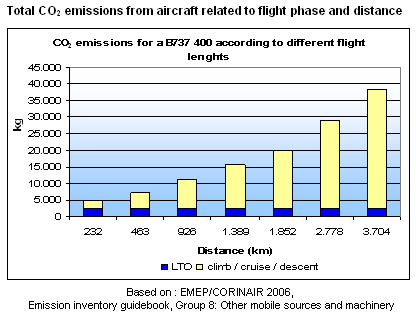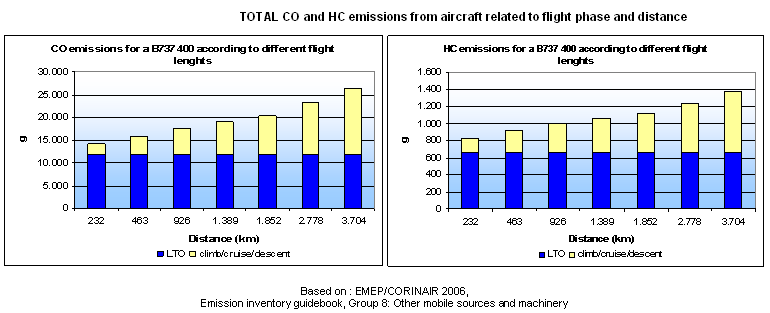(back to the Documentation)
Aircraft emissions
Aircrafts burn fossil fuel (e.g. aviation gasoline, jet kerosene) and emit noise and different pollutants related to the combustion conditions or/and the fuel composition : CO2, NOx, H2O, VOC, CO, PM, SOx. Those pollutants cause several impacts on the environment among others through climate change.
Environmental impacts of different pollutants from fossil fuel combustion

|
Given the fact that combustion conditions (e.g. temperature, atmospheric pressure, etc.) and fuel consumption change according to the engine power developed during each phase of the flight (e.g. taxi, take-off, cruise, etc.), the spreading of the emissions is not homogeneous through the different flight phases. The power setting of the engines during the LTO phase for example will result in higher NOx, CO and unburnt hydrocarbons (due to a less complete combustion) emissions as compared to the power settings used during the cruise phase.
See also: aircraft emissions and climate impacts from the aviation

|
Emissions of CO2 and SO2 are proportional to the amount of fuel burned (as well as to its sulphur contents as far as SO2 is concerned). The total distance flown, the fuel composition, the aircraft type and engine characteristics (e.g. technology, fuel efficiency, etc.) are the crucial influencing parameters to take into account when calculating those emissions.
As regards aircraft, jet fuel has a relatively low sulphur content (less than 0,05% by mass) in comparison with other fuel used in the transport sectors (on the contrary, the majority of the fuels used by the maritime transport have the highest sulfur content).

|
In a combustion process, NOx emissions are influenced by three main factors: fuel composition (nitrogen content), combustion conditions (temperature, time passed in the combustion chamber) or prompt formation of NOx.
For an aircraft, NOx emissions depend mainly on the engine technology and related combustion conditions. As regards one specific aircraft burning kerosene, total NOx emissions are mainly depending on the flight distance.

|
CO and HC (unburned hydrocarbons) are principally generated due to imperfect fuel combustion during the LTO phase. Those emissions are mainly a concern for local air quality issues and local environmental impacts of aviation operations at airports.
